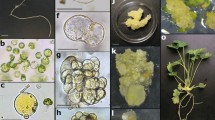Abstract
Sweet orange (C. sinensis L. Osbeck) protoplasts were isolated from nucellar-derived embryogenic callus, cultured in alginate beads for 5–30 days, and the resulting p-calli released by liquefaction and cultured on semi-permeable membranes overlaid on MT culture medium. Somatic embryos did not develop from 5- to 10-day-old p-calli but did develop from 15-, 20-, 25-, and 30-day-old p-calli. There were no significant differences in the numbers of embryos produced among the 15- to 30-day-old p-calli and no abnormal embryo morphologies were observed. The minimum size of p-calli to form embryos was 77.84 μm in diameter. Embryos were smaller from p-calli than those produced from embryogenic callus; p-calli-derived embryos ranged in size between 0.5 and 0.8 mm, while embryos derived from embryogenic callus ranged between 1 and 2 mm.
Similar content being viewed by others
Abbreviations
- BA:
-
6-benzylaminopurine
- CPM1:
-
citrus protoplast medium 1
- GA:
-
gibberellic acid
- HS:
-
heart-shaped
- MC:
-
multiple cotyledon
- MT:
-
Murashige and Tucker
- p-calli:
-
protoplast-derived calli
- PE:
-
plating efficiency
- SE:
-
standard error
References
Ben-Hayyim G, Neumann H, (1983) Stimulatory effect of glycerol on growth and somatic embryogenesis in Citrus callus cultures Z. Pflanzenphysiol. 110: 331–337
Button J, (1978) The effect of some carbohydrates on the growth and organization of Citrus ovular callus Z. Pflanzenphysiol. 88: 61–68
Fleming GH, Olivares-Fuster O, Del Bosco SF, Grosser JW, (2000) An alternative method for the genetic transformation of sweet orange In Vitro Cell Dev. Biol. Plant 36: 450–455
Grosser JW, Ollitrault P, Olivares-Fuster O, (2000) Somatic hybridization in citrus: an effective tool to facilitate variety improvement In Vitro Cell Dev. Biol. Plant 36: 434–449
Hidaka T, Omura M, (1989) Control of embryogenesis in Citrus cell culture: regeneration from protoplasts and attempts to callus bank Bull. Fruit Tree Res. Stn. B 16: 1–17
Kobayashi S, Ikeda I, Nakatani M, (1984) Induction of nucellar callus from orange (Citrus sinensis Osb.) ovules, and uniformity of regenerated plants Bull. Fruit Tree Res. Stn. E 5: 43–54
Kobayashi S, Ikeda I & Uchimiya H (1985) Conditions for high frequency embryogenesis from orange (Citrus sinensis Osb.) Protoplasts. Plant Cell Tiss. Org. Cult. 4: 249–259
Kochba J, Spiegel-Roy P, (1973) Effect of culture media on embryoid formation from ovular callus of ‘Shamouti’ orange (Citrus sinensis) Z. Pflanzenzuchtg 69: 156–162
Kochba J, Spiegel-Roy P, Saad S, Neumann H, (1978) Stimulation of embryogenesis in Citrus tissue culture by galactose Naturwissenschaften 65: 261–262
Kochba J, Spiegel-Roy P, Neumann H, Saad S, (1982) Effect of carbohydrates on somatic embryogenesis in subcultured nucellar callus of Citrus cultivars Z. Pflanzenphysiol. 105: 359–368
Murashige T & Tucker DPH (1969) Growth factor requirements of Citrus tissue culture. Proc. First Intern. Citrus Symp. 3: 1155–1161
Niedz RP, (1993) Culturing embryogenic protoplasts of ‘Hamlin’ sweet orange in calcium alginate beads Plant Cell Tiss. Org. Cult. 34: 19–25
Niedz RP, Hyndman SE, Wynn ET, Bausher MG, (2002) Normalizing sweet orange (C. sinensis (L.) Osbeck) somatic embryogenesis with semi-permeable membranes In Vitro Cell. Dev. Biol. Plant 38: 552–557
Niedz RP, Sussman MR, Satterlee JS, (1995) Green fluorescent protein: an in vivo reporter of plant gene expression Plant Cell Rep. 14: 403–406
Niedz RP, McKendree WL, Shatters RG, (2003) Electroporation of embryogenic protoplasts of sweet orange (Citrus sinensis (L.) Osbeck) and regeneration of transformed plants In Vitro Cell. Dev. Biol. Plant 39: 586–594
Oswara I, (1912) Cytological and experimental studies in Citrus J. Col. Agr. Imp. Univ. Tokyo 4: 83–116
Pérez RM, Galiana AM, Navarro L, Duran-Vila N, (1998) Embryogenesis in vitro of several Citrus species and cultivars J. Hort. Sci. Biotechnol. 73: 796–802
Tomaz ML, Mendes BMJ, Mourao FDA, Demetrio CGB, Jansakul N, Rodriguez APM, (2001) Somatic embryogenesis in Citrus spp.: carbohydrate stimulation and histodifferentiation In Vitro Cell Dev. Biol. Plant 37: 446–452
Webber HJ & Batchelor LD (1943) The Citrus Industry, Vol. 1. Berkeley
Acknowledgement
I wish to thank Mr Eldridge Wynn for his excellent assistance with these experiments.
Author information
Authors and Affiliations
Corresponding author
Rights and permissions
About this article
Cite this article
Niedz, R.P. Regeneration of somatic embryos from sweet orange (C. sinensis) protoplasts using semi-permeable membranes. Plant Cell Tiss Organ Cult 84, 353–357 (2006). https://doi.org/10.1007/s11240-005-9028-4
Received:
Accepted:
Published:
Issue Date:
DOI: https://doi.org/10.1007/s11240-005-9028-4




